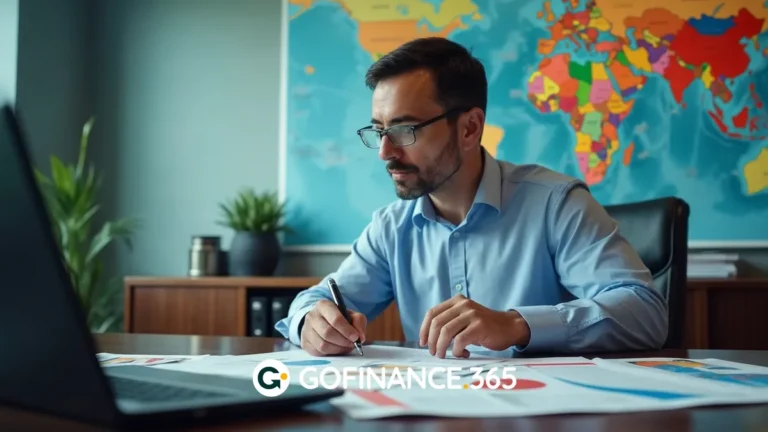Table of Contents:
Did you know that nearly 80% of today’s most successful investors began with limited resources and only a basic understanding of finance? You don’t need a large fortune to start investing—what truly matters is having the right strategy and starting as early as possible. This comprehensive beginner’s guide to investing from scratch is designed to walk you through, step by step, how to make your money work for you.
Our goal is to give you a crystal-clear understanding of all the key elements of investing: from why it’s important to begin now, to defining your financial goals, understanding your risk profile, and learning the best strategies and investment types for beginners.
We’re here to make investing simple, practical, and relevant to your everyday life. Get ready to take charge of your financial future.
Why is it important to start investing as soon as possible?
The earlier you start investing, the greater your opportunity to benefit from compound interest—the powerful effect where your earnings begin generating their own earnings. Think of it like a snowball rolling downhill, growing larger over time: that’s compound interest in action.
Beyond the financial gains, early investing also offers peace of mind. Knowing you’re building a financial cushion for the future helps reduce stress and anxiety about what lies ahead. Investing isn’t just about “getting rich”; it’s also about creating stability and protecting yourself against life’s uncertainties.
Starting early also gives you room to take calculated risks and learn from experience—mistakes cost less when you have time on your side. Investing is a journey, and the sooner you begin, the better equipped you’ll be to seize the opportunities that come your way.
How investing brings you closer to financial freedom
Financial freedom means having enough investment income to cover your needs without relying on an active job. It’s about being able to live life on your own terms—choosing when and how to work, or even whether to work at all.
Think of investing as a powerful tool that helps you break free from financial dependence on wages, paving the way for a more independent and secure future.
First steps before you start investing
If you’re new to investing, laying a solid foundation is essential. Proper preparation helps you avoid common pitfalls and gives you clarity on your goals, allowing you to stay focused even during market ups and downs.
Let’s take a closer look at the key steps to get started from scratch:
Define your personal financial goals
Setting clear goals is the cornerstone of successful investing. A goal isn’t just a wish—it’s a specific target that answers key questions like:
- What am I trying to achieve with this investment?
- How long do I have to reach this goal?
- How much money will I need?
You can break down financial goals by timeframe:
- Short term (1–3 years): Saving for a trip or a down payment on a home.
- Medium term (3–10 years): Children’s education, home renovations, etc.
- Long term (10+ years): Early retirement, achieving financial independence.
Having this clarity from the beginning helps you choose the right investment tools and stay motivated—even when the market gets turbulent.
Know your risk profile as an investor
Your risk profile reflects both your willingness and your capacity to tolerate short-term losses in exchange for potential long-term gains. Understanding your risk tolerance helps prevent emotional decisions that could harm your long-term plan.
There are three common risk profiles:
- Conservative: You prioritize safety over returns.
- Moderate: You’re open to some risk for balanced growth.
- Aggressive: You can tolerate volatility for the chance of higher returns.
Set up an emergency fund before investing
An emergency fund is a fundamental part of any responsible financial plan. Ideally, it should cover three to six months of essential living expenses.
Why is this so important? Because it protects you against unexpected events like job loss, medical emergencies, or urgent home repairs. With a solid emergency fund in place, you won’t need to dip into your investments during tough times.
Keep this fund in liquid and secure products, such as a high-yield savings account or a short-term deposit. Here, accessibility matters more than returns.
Basic investment strategies for beginners
When you’re just starting out, simplicity is your best ally. There’s no need to jump into complex financial instruments before you understand the basics.
Two of the most effective beginner strategies are diversification and progressive investing in small amounts. These approaches help you build a well-balanced portfolio and learn by doing.
Let’s dive into them:
Diversification: Why It’s essential
Diversification means spreading your investments across various assets, sectors, and regions to reduce risk. If one investment underperforms, others can help balance out the impact. Key benefits include:
- Reduced portfolio volatility.
- Protection against sector-specific downturns.
- Increased chances to capture gains across markets.
Remember, diversification doesn’t mean investing randomly. It’s about thoughtfully selecting assets that complement each other and balance your risk.
Investing with little money: Accessible options
Thanks to technology, investing small amounts is easier than ever. Digital platforms have made the markets more accessible, enabling you to begin with minimal capital. Some beginner-friendly options include:
- Fractional ETFs: Buy a portion of a fund, enabling diversification with a low budget.
- Robo-advisors: Automated platforms that manage your portfolio based on your risk profile.
- Real estate crowdfunding: Invest in property projects with small contributions.
- Micro-investing apps: These round up your everyday purchases and invest the difference.
It doesn’t matter how much you start with. What matters is consistency and building the habit over time.
Recommended types of investments for beginners
With so many options out there, it’s normal to feel overwhelmed. Fortunately, some investment tools are particularly beginner-friendly due to their simplicity, accessibility, and built-in diversification.
Here are the most recommended:
Index funds and ETFs
Index funds and ETFs (exchange-traded funds) track the performance of market indexes like the S&P 500 or MSCI World. They’re excellent for beginners because:
- They offer instant diversification.
- They come with low fees.
- They require little active management.
- With one purchase, you can invest in dozens or even hundreds of companies across different industries and regions.
Bonds and interest-bearing accounts
Bonds are debt instruments that pay you interest over time—ideal for stability and predictability in your portfolio. Issued by governments or corporations, they’re typically less risky than stocks.
Interest-bearing accounts, on the other hand, offer a guaranteed return and are perfect for your emergency fund or to hold cash while you plan your next move.
Shares in established companies
Buying shares in large, reputable companies—often called “blue chips”—is a smart way to begin exploring the stock market. These companies are generally more stable and may pay dividends, offering you steady, passive income.
Low-Risk alternative investments
If you’re looking to diversify further, consider beginner-friendly alternatives like:
- Real estate crowdfunding: Join others to invest in property projects.
- Peer-to-peer lending (P2P): Lend money to individuals and earn interest.
- Digital gold or stable cryptocurrencies: Use these to hedge against inflation or diversify your holdings.
These alternatives can add flexibility and potential growth to your overall investment strategy.
How to create your first investment plan step by step
Now that you have the basics, it’s time to build a personalized plan that fits your financial goals and market realities. Follow this structured process to move forward confidently:
Determine how much you can invest monthly
Before selecting any assets, calculate how much you can comfortably invest each month. Review your budget and set aside a consistent percentage.
A good starting point is between 10% and 20% of your income—just make sure your emergency fund is in place first.
Choose the right platforms to get started
Look for secure, regulated investment platforms with competitive fees. Evaluate:
- User experience and ease of navigation.
- Range of products available.
- Reviews from other investors.
Monitor and adjust your strategy over time
Keep an eye on your portfolio at least quarterly to ensure it aligns with your evolving goals. Adjust your investments as your life changes or market conditions shift.
Remember: investing is a long-term journey. Periodic reviews help keep your plan on track and ensure you’re always moving toward financial freedom.
You don’t need a lot of money or expert-level knowledge to get started. Begin today, stay consistent, keep learning, and refine your approach along the way—and you’ll steadily move closer to your financial goals.
Frequently asked questions about how to start investing from scratch
Before we wrap up, let’s answer some of the most common questions beginners ask when they’re about to start investing:
Is It better to invest in stocks or funds as a beginner?
For beginners, index funds or ETFs are generally the better choice. They offer broad diversification, lower costs, and require less technical expertise compared to picking individual stocks.
What should i learn before i start investing?
Before you dive in, make sure you understand basic investment concepts like risk, return, diversification, and compound interest. Learn how the stock market works and explore different investment vehicles. Financial education is your most valuable first investment.















